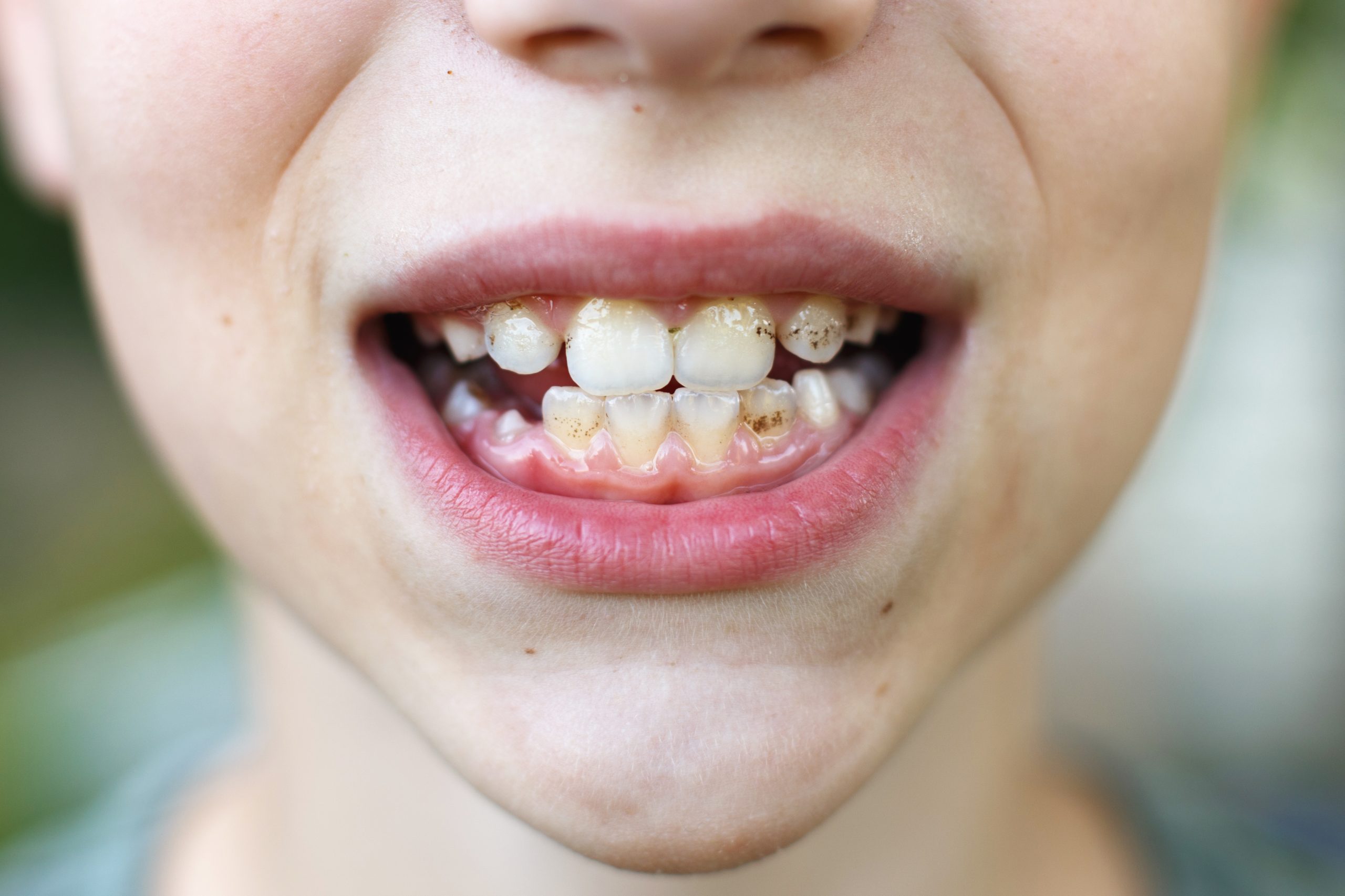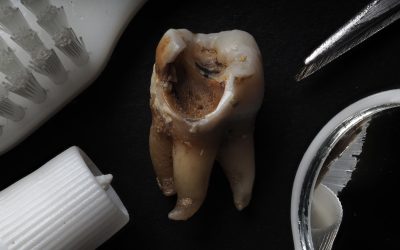Overview: Tooth Decay
Tooth decay or dental caries refers to areas in the hard surface of the teeth that are damaged, meaning they have tiny openings or holes that bring forth other dental problems like toothache, tooth infection, and tooth loss.
What Causes Tooth Decay?
Tooth decay is generally caused by bacteria overgrowth in the mouth. While a healthy mouth has healthy bacteria that create a good oral microbiome balance, bacterial overgrowth causes problems including tooth decay. The most common causes of bacterial overgrowth in the mouth include: [1]
1. Excessive Consumption of Sugary Drinks/Snacks & Poor Oral Hygiene
When you consume a lot of sugars or starchy foods, and fail to maintain proper dental health,to bacteria have a reason to thrive and cling on the teeth, forming a sticky film known as plaque. The bacteria also produce acid (as a waste product) which kickstarts erosion of tooth enamel and the tooth decay process. [2]
2. Other Causes of Tooth Decay and Risk Factors
There are other causes/contributing factors to consider. They include, but aren’t limited to:
- Tooth susceptibility: Factors such as a thin tooth enamel can increase susceptibility to tooth decay. Some teeth are also more susceptible to decay than others. For instance, back teeth located at the back of the mouth (molars and premolars) are harder to clean because of their many grooves and pits, making them more prone to decay. [3]
- Saliva: Salivary gland conditions such as reduced saliva flow (linked to dry mouth) also increases risk for tooth decay since saliva is instrumental in neutralizing acids in the mouth as well as remineralizing teeth. [4]
- Some conditions like acid reflux (gastroesophageal reflux disease): stomach acid that gets into the mouth can erode the enamel and cause decay. [5]
- Lack of fluoride: Fluoride protects the teeth from demineralization linked to acid in the mouth. [6]
- Worn fillings/dental devices: Worn dental fillings can create “pockets” where dental plaque accumulates and causes dental decay.
Given the various causes, it helps to book a dental appointment if you suspect you have tooth decay. Dentists are the best-placed healthcare professionals to diagnose decay and the precise underlying cause/s.
Teeth Decay Symptoms
Now that you know the main causes and risk factors, let’s shift our focus to the signs of tooth decay. How do you know you have tooth decay? Well, it’s worth noting that tooth decay may not be accompanied by any symptoms at all. As the decay progresses, there are aspects people tend to associate with common symptoms of tooth decay, such as: [7]
- Tooth pain (mild or sharp pain when drinking/eating hot, sweet or cold food). Pain tends to be more pronounced when biting down.
- Tooth sensitivity
- Visible holes or pits in the teeth
- Black, white or brown staining on the tooth surface
- Bad breath
However, these aspects can’t be 100% associated with tooth decay which is why we recommend you book a consultation with us and allow our team to analyze your situation.
What Does Tooth Decay Look Like?
As mentioned, the early stages of decay may not have any symptoms or visible signs. However, as the problem progresses, you can begin to see small, white or chalky spots on the tooth enamel. As the decay worsens, you might also start to see brown/black/dark spots on your teeth. [8]

Stages of Tooth Decay
1. Tooth Decay Beginning: Reversible Stage
As mentioned, the onset of tooth decay happens slowly when bacteria cling to the teeth, forming plaque (a sticky layer). Over time, the bacteria feed on sugars in food, multiplying in the process. The bacteria also excrete acids that work on the tooth enamel, forming white spots over time.
2. Irreversible Tooth Decay
If you don’t take the necessary action when you notice white spots, these will grow in size, marking the onset of symptoms like pain. You may also start having very weak or broken teeth. At this point, it’s already too late. In most cases, a dental filling won’t work and other dental treatments like a root canal are necessary.
Can You Reverse Tooth Decay? How to Stop Tooth Decay Getting Worse
Yes! At the early stage, the decay is reversible through simple measures such as reducing the intake of sticky food and/or sugary foods/drinks. If you change your diet and maintain good oral hygiene through regular brushing and flossing, you can reverse the problem. However, once the decay progresses, there is no way to reverse it and stronger measures are needed.
Can Tooth Decay Spread to Other Teeth? How to Avoid This
While tooth decay doesn’t spread to other teeth, it is common for the problem to affect adjacent teeth. This is because the factors causing decay in one tooth can cause it in the other as well; the bacteria overgrowth in a tooth is likely to happen next to nearby teeth. What’s more, persons susceptible to tooth decay are bound to get the problem on most if not all teeth as opposed to the problem jumping from one tooth to another.
Tooth Decay In The Gum Line
Tooth decay can happen close to the gum line or under the gum line, making it very difficult to deal with. In such instances, the gum needs to be removed through a special surgery to address the problem. We strongly suggest you don’t wait until it gets to this point.
Tooth Decay: What’s the Best Treatment?
Assuming you have a decayed tooth, we offer the following treatment options:
- Dental fillings: This treatment is available for decay at the early stages
- Root Canal: If you have irreversible decay, root canal treatment will deal with decay that has affected the pulp and caused a serious infection.
- Tooth Extraction: In very severe cases like a severely damaged tooth characterised by a lot of decayed material, the tooth must be removed.
- Dental crown: If the tooth damage isn’t severe, a crown can be placed over the tooth instead of removing the tooth.
As mentioned, treatment will depend on the stage/severity of the problem and the condition of the tooth. Book an appointment at The Little Green Building to get the best advice and treatment for tooth decay in Toronto, Bloor West.
How Do I Prevent Tooth Decay?
If you have been affected by tooth decay or seen the effects firsthand, what can you do to prevent the problem?
- Good oral hygiene: You need to brush at least twice daily and floss at least once daily before bedtime. Remember to pay attention to back teeth.
- Go for regular dental check-ups: A good dental hygiene routine isn’t enough. There are still hard-to-reach areas in the mouth, in-between the back teeth. You need to see a dentist at least once every 6 months for professional cleaning and early detection of tooth decay among other dental conditions like dry mouth and gum disease.
- Maintain a tooth-friendly diet: As mentioned above, acid-producing bacteria in the mouth love sugary foods/drinks, avoid these and maintain a healthy diet (eat plenty of fresh fruit and vegetables that boost oral health). What’s more, drink plenty of water to neutralize mouth acids as well as stimulate saliva production.
Tooth Decay Vs. Cavity
Tooth decay and cavities are essentially the same thing. Tooth decay is the process that leads to cavities, which are the actual holes or damage in your teeth. When bacteria in your mouth feed on sugars and starches, they produce acids that gradually break down your tooth enamel. Over time, this decay creates cavities—permanent areas of damage that require treatment to prevent further deterioration. So, while “tooth decay” describes the process, “cavities” are the result of that process.
Do you have any other questions about tooth decay? Book an appointment with Dr. Michael Paltsev – Leading dentist at The Little Green Building.
Get firsthand knowledge as well as tooth decay treatment in Toronto for both adult and childhood caries. Book a dental visit in person (Google Maps). Email: littlegreenbuilding@gmail.com or Call now: (416) 769-8135.
References
[1] Mayoclinic: https://www.mayoclinic.org/diseases-conditions/cavities/symptoms-causes/syc-20352892
[2] National Institute of Dental & Craniofacial Research: https://www.nidcr.nih.gov/health-info/tooth-decay#:~:text=Tooth%20decay%20begins%20when%20bacteria,infection%2C%20and%20even%20tooth%20loss.
[5] Healthline: https://www.healthline.com/health/gerd/gerd-teeth
[6] MedicalNewsToday: https://www.medicalnewstoday.com/articles/154164
[8] ClevelandClinic: https://my.clevelandclinic.org/health/diseases/10946-cavities





